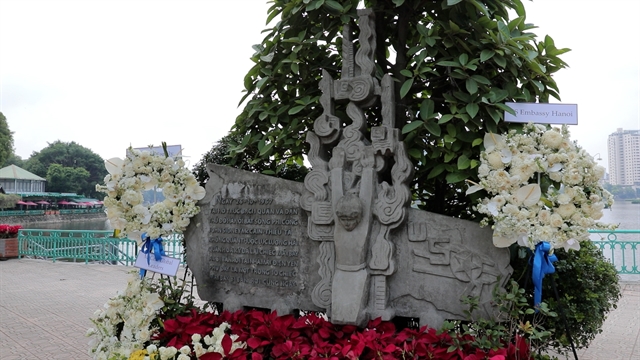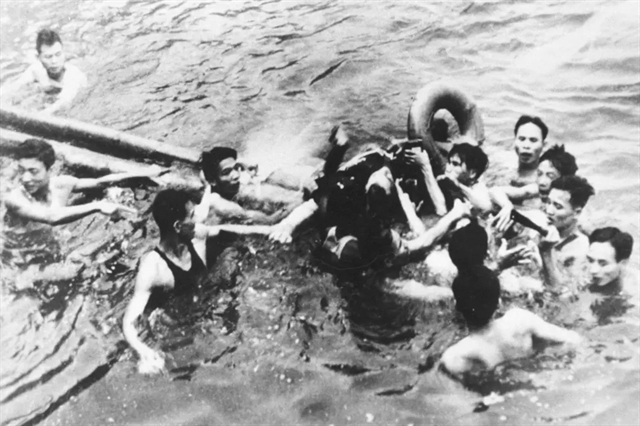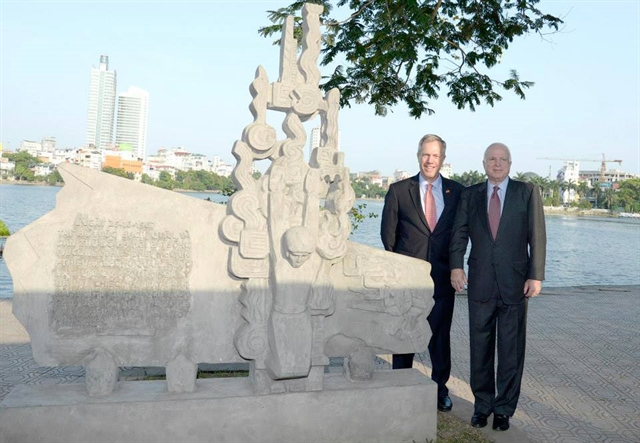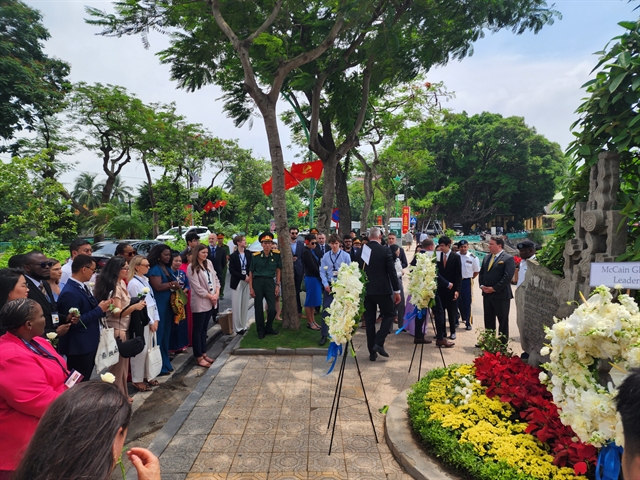 Politics & Law
Politics & Law

 |
| The John McCain memorial in tribute of the POW-turned-Senator on Trúc Bạch Lake in Hà Nội. VNS Photo Nhật Hồng |
At the middle of the tree-lined Thanh Niên Road, sandwiched between two big lakes in Hà Nội, stands an understated memorial depicting an American – a figure whose presence in Việt Nam, once defined by conflict, evolved into a symbol of reconciliation.
Depicted a US air force pilot shot down over Hà Nội sky, the subject of the humble monument, this is the sole public statue of an American in all of Việt Nam.
And just as the relationship between Việt Nam and the United States underwent drastic shifts in the decades following the brutal war and the reunification of Việt Nam in 1975, so too has this little sculpture silently borne witness to the metamorphosis of nations once locked in bitter hostilities.
The story of how it all came to be was a dramatic episode in the height of the war of destruction that the US waged against North Việt Nam – one that is still barely justifiable to this day.
On October 26, 1967, as part of the aerial bombing operation nicknamed Rolling Thunder, a 20-year-old pilot John McCain flew on the A-4 Skyhawk along with 19 American aircraft with the mission of blowing up the critical Yên Phụ Power Plant in Hà Nội, which boasted the largest capacity in the entire northern region at the time, in order to cut off electricity supply for the capital city along with neighbouring provinces.
However, surface-to-air missiles from the Vietnamese army's 61st Battalion managed to down about half of the squad.
McCain's airplane was hit and free-fell towards the ground, so he decided to eject himself. During the chaotic moment, he badly injured both his arms and broke a knee. Still, his parachute opened in time and he eventually landed in the waters of Trúc Bạch Lake.
With the amount of gear on his body weighing over 20kg, he was quickly sinking, but used the remaining intact leg to kick towards the surface. Not being able to flap his arms to swim, he again began to sink.
However, this brief moment at the surface earned him enough time for some local residents, currently hiding in bomb shelters, to approach where he was struggling and pull him to shore.
Barely conscious, McCain described the crowd as angry, but they saved him and brought him to Hoả Lò Prison, built by the French in the late 19th century to jail political prisoners and at the time used by North Việt Nam to hold prisoners of war (POWs) during the US war.
He would spend five and a half years in captivity at the 'Fiery Furnace' – or, as the American prisoners called it, the Hanoi Hilton – before he was released in 1973 after the Paris Agreement was signed between the US and Việt Nam.
 |
| Hanoian people and soldiers pulled John McCain out of Trúc Bạch Lake. File Photo |
Local authorities erected a memorial in 1984 to commemorate this victory.
"On October 26, 1967 at Trúc Bạch Lake, Hà Nội's people and armed forces captured US Air Force Major John Sney Ma Can (sic) who flew the A-4 aircraft shot down at the Yên Phụ power plant, one of ten planes shot down that day," the inscription originally reads, on the side of the image of an airman on his knees with his hands above his head in front of a wing of the downed plane that bears the abbreviations USAF (United States Air Force).
Later in 2015, after a renovation, it was revised to correct the name of McCain, his rank and military branch, and drop negatively charged words to make the text more formal and fair, according to former US Ambassador to Việt Nam Ted Osius.
As a result, the narrative of the memorial, or what it stands for, has moved from the original bravado of triumph over foes to a testament to mended ties.
Bearing no bitterness for prison time in Hà Nội, McCain himself visited the site several times during his trips to Việt Nam after both nations normalised ties, and appeared to have taken a liking for it, not least for the fact it was the only statue bearing his image in the world.
A former Vietnamese Ambassador to the US, Nguyễn Tâm Chiến, said in his book that during his meeting with McCain in 2002, McCain led him to the photo of the cement memorial displayed in his office, asking with a little twinkle in his eyes that the ambassador would send a message back to Hà Nội that Senator John McCain wished the "little lakeside statue" could always be kept clean.
Chiến only later learned McCain said this because the last time he visited the site in Hà Nội, he saw some bird droppings on it.
And it seemed the message had been received – it is hard not to accommodate this one small request from one of the American architects of the normalisation of ties between the two nations.
 |
| Senator John McCain (right) and former US Ambassador to Việt Nam Ted Osius besides the McCain memorial. Photo from the US Embassy in Việt Nam |
After McCain's passing in 2018, as both countries' relations flourish, the memorial has become an essential pilgrimage site for US delegations, including US President Joe Biden and Vice President Kamala Harris.
The McCain Institute, set up in his honour, in 2022 began a Global Leaders programme, which would include a Việt Nam visit, with stops in Hà Nội to include Hoả Lò Prison and the memorial itself.
At a commemoration event held on May 20 at the memorial in Hà Nội that gathered over 30 leaders from over 20 countries under the programme, US Ambassador to Việt Nam Marc Knapper spoke highly of the courage of McCain, along with other Americans like John Kerry and Patrick Leahy.
Knapper described them as "willing to go against the political grain of the time to advocate on behalf of reconciliation," also praising the courage among Vietnamese at that time, Vietnamese who were "also going against the political grain to argue in favour of friendship and reconciliation after the bitter war between our two countries".
President Bill Clinton initiated the process of normalising diplomatic relations in the 1990s. A crucial step occurred in early 1994, when the US lifted its 30-year trade embargo on Việt Nam.
This decision was made after concluding that substantial progress was being achieved on the POW/Missing in Action issue, helped in no small part by McCain and company, whose tireless advocation for full relations with Việt Nam, and his bearing of no antagonism towards the Vietnamese Government despite being held captive for years, earned backing from both his own Republican party and the Democratic party.
 |
| US Ambassador Marc Knapper joined leaders and scholars of the McCain Institute, and representatives from the Ministry of Foreign Affairs and the leadership of Tây Hồ District, along with emerging leaders from around the world, to lay flowers at the John McCain Marker on Trúc Bạch Lake in Hà Nội on May 20. VNS Photo Trọng Kiên |
Tom Seaman, Foreign Affairs officer at the US Department of State, and one of the members of the leaders' delegation, remarked at the commemoration event that undoubtedly one of McCain's most significant contributions was crossing the political divide within the US to help restore relations between Việt Nam and the US, which resulted in both countries moving forward together to heal.
"Some 30 years after normalisation of relations, and seven years after Senator McCain's passing, the relationship between Việt Nam and the United States has grown into a mutually beneficial and comprehensive strategic partnership," Seaman said in his speech.
The US diplomat said that in his efforts towards the reconciliation between Việt Nam and the US, McCain demonstrated not only moral courage, but also a "just and strategic vision for both countries, along with the ability to learn from and honour the past without being imprisoned by it".
As the two countries celebrate the 30th anniversary of diplomatic relations this year, Hà Nội's authorities have greenlit a VNĐ1.4 billion (about US$54,000) project to renovate the McCain memorial to ensure this landmark would be commensurate to the friendship between both sides.
This would include enlarging the size of the memorial by about 20 per cent, changing the material to more durable granite and moving the memorial further back to create space in front for diplomatic delegation visits, according to Bùi Thị Lan Phương, deputy chief of Tây Hồ Ward.
Significantly, while the text description is currently correct, the abbreviation USAF on the wing's plane would also be altered to USN to be in line with the text and McCain's plane.
The changes had taken into account feedback from Hà Nội's leadership, the foreign ministry of Việt Nam and the US embassy, Phương said.
It was expected that the renovation works would be finished in mid-June, and there will be a ceremony marking the completion, the official said. VNS




